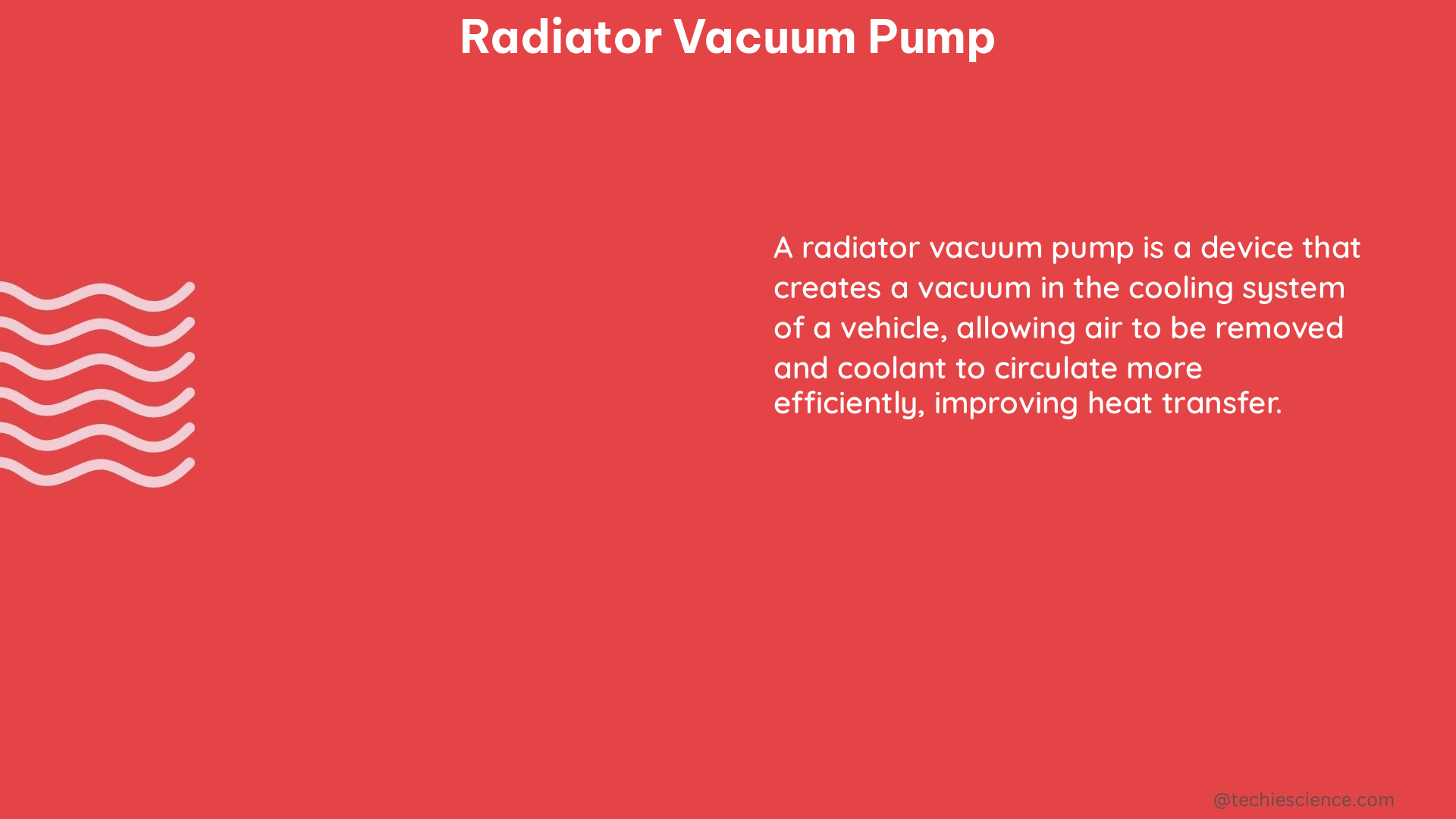A radiator vacuum pump is a specialized tool used to efficiently remove air from a vehicle’s cooling system, ensuring optimal heat transfer and proper coolant circulation. This essential device plays a crucial role in the process of bleeding and refilling cooling systems, particularly in cases where the system has been drained and requires a complete refill.
Understanding the Mechanics of a Radiator Vacuum Pump
The radiator vacuum pump works by creating a vacuum within the cooling system, which in turn draws out any trapped air pockets or bubbles. This process allows the coolant to fill the system completely, eliminating the risk of air-related issues that can lead to overheating and potential engine damage.
Key Components of a Radiator Vacuum Pump
-
Vacuum Gauge: This component measures the vacuum pressure within the cooling system, allowing the user to monitor the progress and ensure the desired level of vacuum is achieved.
-
Venturi Tube: The venturi tube is responsible for generating the vacuum by utilizing the Bernoulli principle, which states that as the speed of a fluid increases, the pressure within that fluid decreases.
-
Hose and Fittings: The hose and fittings are used to connect the vacuum pump to the cooling system, typically at the coolant degas bottle or radiator.
Vacuum Pressure Considerations
The vacuum pressure required to effectively remove air from the cooling system can vary, but a vacuum of approximately 25 inches of mercury (hg) is often recommended. This level of vacuum is generally sufficient to draw out any trapped air, ensuring a complete and efficient fill of the system.
Proper Procedures for Using a Radiator Vacuum Pump

Utilizing a radiator vacuum pump correctly is crucial to ensure the cooling system is filled properly and any potential leaks are identified. Here’s a step-by-step guide:
-
Prepare the Cooling System: Ensure the cooling system is drained and the radiator or coolant degas bottle is accessible.
-
Connect the Vacuum Pump: Place the vacuum pump’s head in the coolant degas bottle or radiator, and attach the venturi tube and air hose.
-
Create the Vacuum: Operate the vacuum pump to build a vacuum within the cooling system, monitoring the vacuum gauge to reach the desired level (approximately 25 hg).
-
Check for Leaks: With the vacuum established, carefully inspect the cooling system for any signs of leaks. If leaks are detected, address them before proceeding.
-
Fill the Cooling System: Once the vacuum is maintained and no leaks are present, slowly introduce the coolant into the system, allowing it to fill completely.
-
Bleed the System: After filling, follow the manufacturer’s recommended procedures to bleed any remaining air from the cooling system.
-
Verify Proper Operation: Start the engine and monitor the cooling system’s performance, ensuring proper circulation and no signs of air pockets or overheating.
Benefits of Using a Radiator Vacuum Pump
The use of a radiator vacuum pump offers several key benefits:
-
Efficient Air Removal: The vacuum pump effectively removes 100% of the air from the cooling system, ensuring optimal heat transfer and circulation.
-
Ease of Use: The vacuum pump simplifies the bleeding and filling process, making it more accessible for DIY enthusiasts and professional mechanics alike.
-
Quick and Efficient Filling: The vacuum-assisted filling process allows the cooling system to be refilled quickly and efficiently, reducing downtime.
-
Leak Identification: Using a vacuum pump can help identify any leaks in the cooling system, allowing for prompt repair and maintenance.
Technical Specifications and Considerations
When selecting a radiator vacuum pump, there are several technical specifications to consider:
| Specification | Typical Range |
|---|---|
| Vacuum Pressure | 20-30 inches of mercury (hg) |
| Hose Length | 3-6 feet |
| Venturi Tube Material | Brass or stainless steel |
| Gauge Accuracy | ±1-2% of full scale |
| Power Source | Manual, electric, or pneumatic |
Additionally, it’s important to ensure the vacuum pump is compatible with the specific cooling system and vehicle you’re working on, as some models may have unique requirements or connections.
Conclusion
The radiator vacuum pump is an essential tool for efficiently removing air from a vehicle’s cooling system, ensuring optimal heat transfer and proper coolant circulation. By understanding the mechanics, proper procedures, and technical specifications of this device, DIY enthusiasts and professional mechanics can effectively maintain and service cooling systems, ultimately extending the lifespan of the engine and preventing costly repairs.
References
- Testing of CO2 on-orbit fill/refill for the upgraded tracker thermal pump system in the Alpha Magnetic Spectrometer. (2020). International Journal of Thermal Sciences, 156, 106496. https://doi.org/10.1016/j.ijthermalsci.2020.106496
- Using a vacuum to refill the cooling system. What is the max vacuum… (n.d.). Pantera Infopop. https://pantera.infopop.cc/topic/using-a-vacuum-to-refill-the-cooling-system
- Bleeding And Filling Cooling System With Vacuum Filler … – YouTube. (2015, May 27). YouTube. https://www.youtube.com/watch?v=1beZZCBUnt0
- Hand Vacuum Pump Coolant System Question 2008 C6. (n.d.). Corvette Forum. https://www.corvetteforum.com/forums/c6-tech-performance/4567402-hand-vacuum-pump-coolant-system-question-2008-c6.html
- Know-How Notes: Using a Radiator Vacuum Tool » NAPA Know How Blog. (n.d.). NAPA Know How. https://www.napaonline.com/know-how/using-a-radiator-vacuum-tool/
- Auto Car Universal Radiator Vacuum Pump Coolant System Purge & Refill Tools Set | eBay. (n.d.). eBay. https://www.ebay.com/itm/193167563857?hash=item2d006e847a:g:zYEAAOSwQQxhKj~X

The lambdageeks.com Core SME Team is a group of experienced subject matter experts from diverse scientific and technical fields including Physics, Chemistry, Technology,Electronics & Electrical Engineering, Automotive, Mechanical Engineering. Our team collaborates to create high-quality, well-researched articles on a wide range of science and technology topics for the lambdageeks.com website.
All Our Senior SME are having more than 7 Years of experience in the respective fields . They are either Working Industry Professionals or assocaited With different Universities. Refer Our Authors Page to get to know About our Core SMEs.